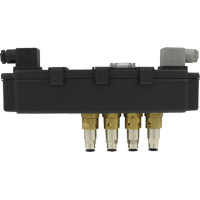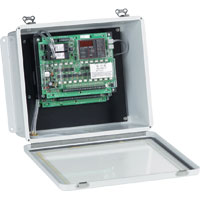Manufacturing an Economic Dust Filtration System
Manufacturing an Economic Dust Filtration System
In the recent tough times and now slight improvements in the global economy many customers have come to Dwyer Sales Engineers asking What can Dwyer do to help with lean manufacturing? Consequentially, in this article we will discuss Dwyer’s Series SVT Solenoid Valve and Timer Enclosure and its cost savings advantages in a dust filtration system.
The Dwyer Series SVT Solenoid Valve and Timer Enclosure was released in 2011 and combines two integral components in a dust filtration system into one package, solenoid valves and a timer controller. In a dust filtration system, solenoid valves are used to send air through a pulse valve, such as our Series RDCS pulse valves. Pulse valves release a quick spurt of air into a dirty dust cartridge filter releasing dust from the filter. The timer portion of the dust filtration system is the brains of the operation controlling when the solenoids fire, the amount of time the solenoids are open, and when the next solenoid in the sequence fires.


In most dust filtration systems, the timer is typically mounted in a separate control panel with wires rather than running to another separate enclosure, which houses the solenoid valves. An example of this would include our Series DCT Timer Board mounted in an enclosure and our Series SVE Solenoid Valve Enclosure would than be wired back to the DCT Timer Board.
The Dwyer Series SVT Solenoid Valve and Timer Enclosure combines solenoids and a timer control in a single outdoor rated package. This design allows manufactures to cut down on the quantity and cost of enclosures needed for a dust filtration system. Additionally, this also results in a reduction in time allotment when wiring timer controls to solenoid valves and mounting the two enclosures.
The SVT Solenoid Valve and Timer Enclosure can be field set for demanding applications that require continuous cleaning, constant pulsing of solenoid valves, or on-demand cleaning; applications that are controlled by a change in pressure usually are done so through a switch. With a 90-240 VAC @ 50 or 60Hz the SVT also helps to prevent additional stocking and inventory of solenoid valves and timers that may only be configured for 120 or 240 VAC inputs of power or not capable of running on systems sold internationally.

On a retrofit or rebuild project of an existing dust filtration system, one may go from a six filter to 10 filter system. On this type of project a new timer board with additional outputs, as well as a new solenoid enclosure with solenoids, would need to be purchased to complete the project. On this same project if an SVT with six channels had originally been used one could purchase an expansion module of four outputs and daisy chain/ wire the two enclosures together. This saves time and money from having to order a new timer board and solenoid enclosure and then discarding the existing timer and solenoids.
By combining two critical components of a dust filtration system into one single device, the Series SVT Solenoid Valve and Timer Enclosure is the perfect answer for your cost savings in initial setup, inventory, as well as future retrofit dust filtration systems.
